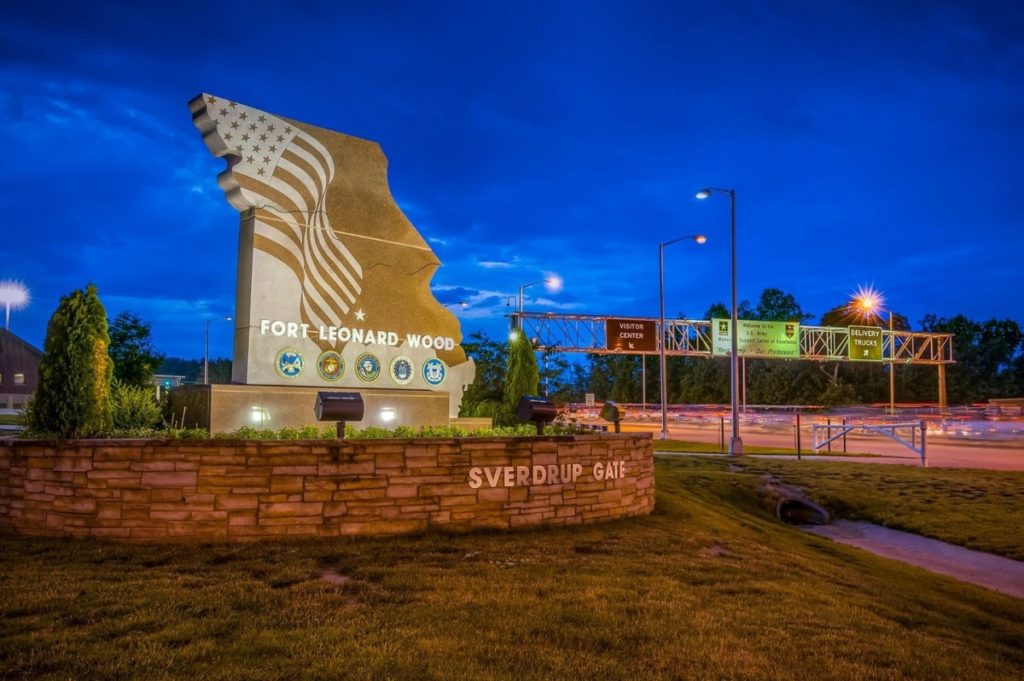Brian Hill
FORT LEONARD WOOD, Mo. (Nov. 9, 2021) — Efforts at Fort Leonard Wood to preserve a piece of the installation’s cultural history have resulted in national recognition.
The National Trust for Historic Preservation honored Fort Leonard Wood with the Federal Partnerships in Historic Preservation Award Nov. 4, during a virtual conference livestreamed from Washington, D.C., for rehabilitation work done here to save Bldg. 2101, also known as the Black Officer’s Club.
The building — renamed Countee Hall in 2019, in honor of the late artist Staff Sgt. Samuel Countee, who painted a mural featured in the building while he was stationed here during World War II — stands as a reminder of a time before segregation in the Army was ended by President Harry Truman in 1948. Countee’s mural is now displayed inside a protective glass case atop the building’s original stone fireplace.
According to Paul Edmondson, NTHP president, the award was created to honor one project each year from all federal agencies that advances the preservation of important historic resources and celebrates a project or program in which a federal agency and one or more non-federal partners achieved an exemplary preservation outcome. It was one of nine preservation awards given by the NTHP this year to individuals and organizations across the nation.
“The National Preservation Awards are an inspiring showcase of how historic preservation continues to evolve as a powerful force that builds stronger communities throughout our country,” he said.
Charlie Neel, chief of the Directorate of Public Works Environmental Division — who has worked on the project since 2013 — called the award “incredibly prestigious.”
“Each year, an untold number of historic preservation projects are completed across the country,” he said. “This award is not just for the building, but it is also for the process — the partnerships between Fort Leonard Wood, the State Historic Preservation Office, the Advisory Council on Historic Preservation and the stakeholders. The end result is incredible and to get to that point took a lot work by everyone involved.”
According to Stephanie Nutt, DPW cultural resource coordinator, the Countee Hall rehabilitation was “the most meaningful project I’ve worked on in my career.”
“I am thrilled for Fort Leonard Wood to be recognized for preserving this important place that tells such a powerful story,” she said. “It’s rare that Army historic preservation projects get national attention and praise and Fort Leonard Wood should be very proud of what has been accomplished with Countee Hall.”
The project began in 2012, Nutt said, and rehabilitation construction started in early 2018, after the completion of a successful historic preservation review that involved a coalition of local, state and national advocates, and the Countee family.
Countee’s niece, Sammie Witing-Ellis, was on-hand to help cut the ribbon at the ceremony to re-open the building in 2019 — Witing-Ellis helped identify her uncle’s mural more than 20 years ago, when she found a matching piece in one of his sketchbooks.
“It’s a monumental day,” Witing-Ellis said at the ceremony. “It’s a landmark, especially for our family (and) the country, to finally recognize a person who contributed so much and who did so much to elevate what was happening at that time, especially to minority Soldiers as they were going forward to represent the country.”
Nutt said meeting Countee’s family members was the highlight of the project.
“My best memories are the ones related to personal connections with the building and the project,” she said. “It was an honor to hear their family stories and see how important the building is to their family.”
Fort Leonard Wood’s Black Officers Club was built in 1941, and is one of just two World War II-era Black officers clubs to remain standing. The rehabilitation project included work on the original stonework that was laid by German prisoners of war. The transformed, multi-use facility now includes a classroom, meeting and event space and is open for public visitation. Posted signage inside and outside the building alludes to its importance.
Nutt, who has worked on the project since its beginning, called Countee Hall and other significant historical locations, “tangible reminders of our past.”
“They are the places and things that evoke strong emotions and memories, and teach us about our history,” she said. “It’s important to preserve places that help to tell the full story of our nation’s history and represent the people associated with those places.”
Neel said this is the third of three significant awards Countee Hall has received. The project was previously awarded a Preserve Missouri Award and an Advisory Council on Historic Preservation Chairman’s Award.
“Countee Hall is a touch stone to our past,” he said. “It helps us understand our culture and it helps to explain who we are as a people, a community and as a nation.”
Visit the NTHP Facebook page at www.facebook.com/NationalTrustforHistoricPreservation for more information on the 2021 National Preservation Awards.


-30-
About Fort Leonard Wood
Fort Leonard Wood is a thriving and prosperous installation that has evolved from a small basic training post 80 years ago to a premier Army Center of Excellence that trains nearly 80,000 military and civilians each year.
Fort Leonard Wood is home to the U.S Army Maneuver Support Center of Excellence and three U.S. Army schools: the U.S. Army Engineer School; U.S. Army Chemical, Biological, Radiological and Nuclear School; and the U.S. Army Military Police School. In addition to training engineer, CBRN and military police specialties for the Army, Fort Leonard Wood also provides gender-integrated in-processing and Basic Combat Training for new Soldiers.
Fort Leonard Wood also hosts and trains with the largest Marine Corps Detachment and Air Force Squadron on any Army installation as well as a large Navy construction detachment.
More information about Fort Leonard Wood is at: https://home.army.mil/wood/index.php/about/mission


